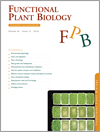
Functional Plant Biology
Volume 45 Number 12 2018
FP17356Differentially expressed ZmASR genes associated with chilling tolerance in maize (Zea mays) varieties
This study examines the role of ASR during chilling stress in maize. The results showed that the expression of ZmASR is a chilling response option in maize, and the expression of ZmASR increased under chilling conditions. These results can be used to cultivate new transgenic maize varieties with cold resistance to assist the stable yield of maize in northern China.
FP17283How does long-term drought acclimation modify structure-function relationships? A quantitative approach to leaf phenotypic plasticity of barley
Examining leaf plastic responses as part of drought acclimation processes is critical for understanding the future consequences of climate change on plant survival and crop productivity. Given that phenotypic plasticity influences environmental tolerance and that the structure of the leaves expanded after the onset of drought changes, we examined the acclimation processes of three different barley genotypes using a multi-trait plasticity assessment with an emphasis on the leaf water economy-related traits. Results revealed trade-offs orchestrating long-term drought acclimation, which could become the first step in the construction of a multi-trait plasticity index that could be used in assessing tolerance as well as drought impact among different crop genotypes.
FP17247Exogenous induction of thermogenesis in Arum concinnatum by salicylic acid

Thermogenic plants have the ability to attract insects raising their temperature above that of the surrounding air. Here we attempt and explore the ex situ exogenous induction of thermogenesis in whole Arum lily inflorescences, which we achieved using salicylic acid. Our results release the laboratory experiments on thermogenesis from the start time of thermogenesis in nature, offer a tool for the study of physiological limitations of thermogenesis in extreme environmental conditions, and provide an innovative solution in specific heat production demands.
FP18012Chitosan and spermine enhance drought resistance in white clover, associated with changes in endogenous phytohormones and polyamines, and antioxidant metabolism
The interaction of chitosan and polyamines could be involved in mitigating drought stress in white clover. This research aimed to determine the effect of co-application of chitosan and spermine on improving drought tolerance. We found that co-application of chitosan and spermine was more effective than either chitosan or spermine alone in mitigating drought stress. Our results demonstrate the potential advantage of further studies on improving drought tolerance in white clover.
Rotamase cyclophilin protein has a key role in plant development and various stress signal pathways. Here, two BrROC1 family genes from Tsuda turnip were induced not only by UV-A light in pigmented tissues but also by high or low temperatures, dehydration, and osmotic and salt stresses. These results indicate that BrROC1 genes are involved in light induction response and in adaptation to various environmental stresses of plants.
Climate changes are increasing the frequency of crop stress events, particularly in the Mediterranean region where dryland olive farming remains a sustainable practice. We aimed to evaluate how olive plants under irrigated versus dryland farming regimes respond to heat plus high UV-B, and recover. The results suggest that plants pre-exposed to drought can modulate tolerance mechanisms towards coping with further multiple stress episodes and recovery.
FP18083Functional validation of the Pi54 gene by knocking down its expression in a blast-resistant rice line using RNA interference and its effects on other traits
Worldwide rice blast disease caused by Magnaporthe oryzae is a major challenge to rice production. This study used a RNAi-based approach to demonstrate that the blast resistance gene Pi54 is responsible for M. oryzae resistance in rice. We also discovered the off-target effect of RNAi in RNAi knockdown rice lines, leading to delayed flowering. Therefore, this study validates the functional role of Pi54 and also highlights the off-target nature of RNAi.
FP18117Riboflavin (Vitamin B2) mediated defence induction against bacterial leaf blight: probing through chlorophyll a fluorescence induction O–J–I–P transients
Bacterial leaf blight (BLB) disease in rice causes a huge reduction in grain yield caused by damage to leaf chlorophyllous tissue. The effect of riboflavin treatment on BLB-infected rice varieties with different degrees of susceptibility was studied through a chlorophyll fluorescence technique. Riboflavin treatment reduced disease incidence, improved PSII activity and thus yield in BLB-infected plants.



